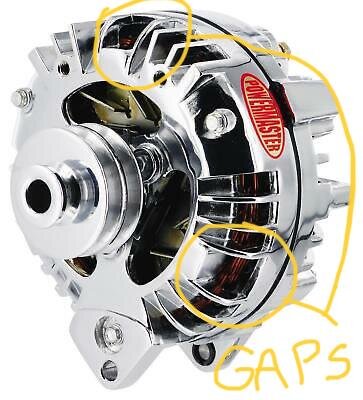1963JAM
Well-Known Member
- Local time
- 10:02 AM
- Joined
- Sep 5, 2021
- Messages
- 306
- Reaction score
- 171
- Location
- Worcester County Massachusetts

Yes. I recently joined FBBO after my recent purchase of a 66 Satellite.Is that a 65 in picture with pulley? If so probably the original alternator, don't let it go.
What did these original alternators put out for amperage. Can it rebuilt to a higher amp ooutput?ABSOLUTELY DO NOT TRADE IT IN.....correct on the date code....the 37th week of 1966. The second pix shows the origional Mopar assembly number and the assembly date. The first pix shows the sheave's (pulley) part number (just barely visable). The end view shows the the old "Forward Look" logo + the other pix dhows the casting number and casting number "clock" as to when it was cast. After disassembly and cleaning and reassembled with new parts, it will look better than the chromed unit and work as good as new. Just my opinion of course. To someone doing a numbers matching restoration this will be a great addition to the effort.......put in the FOR SALE section and state the price....
BOB RENTON
What did these original alternators put out for amperage. Can it rebuilt to a higher amp ooutput?
Figured more amps is better. Learned a few things from this thread, and second guessing myself if the Pure Energy 60 amp alternator I purchased from Rockauto was such a good idea.Why do you want more amps?
Were alternators painted black originally? I'll hold onto it and look into having it rebuilt. Would this alternator have been used with the 440 engine and group 27 battery?The origional alternator was rated at 37 amps, or 46 amps when there were additional loads and with a two groove sheave when used on a B/RB block with A/C. The origional alternator 1960-61 vintage used germanium diodes; later units and higher capacity units used silicon diodes. Higher capacities in origional alternators can be realized by changing to a higher amperage stator assembly and the higher capacity diodes. The rotor can be reused as it is basically the same regardless of capacity assuming that the drive sheave is the same. Just my opinion of course.
BOB RENTON
Yikes! Never thought about the extra amperage on the wiring, especially 55 year old wiring.Your wiring doesn’t need more amps. It is normal to have it discharge at idle with the lights on. That is all systems normal for a 1966.
No....the alternators were originally a natural aluminum color, the visable stator windings were usually a reddish-maroon color and the stator frame was a natural steel gray color. Your pix shows a black undercoat color....perhaps from the undercoat or spray on undercoat or just accumulated underhood crud after many years. R413's observation/suggestion is true....just run what you have as is. I'm sure others will disagree and have you rewiring all the wiring, including the bulkhead connectors, eliminating the ammeter, installing an aalternator big enough amp wise to arc weld with. But its your car....enjoy it as is....its only origional....once.Were alternators painted black originally? I'll hold onto it and look into having it rebuilt. Would this alternator have been used with the 440 engine and group 27 battery?
I plan on keeping it simple and original as possible. Dependability is my main objective.No....the alternators were originally a natural aluminum color, the visable stator windings were usually a reddish-maroon color and the stator frame was a natural steel gray color. Your pix shows a black undercoat color....perhaps from the undercoat or spray on undercoat or just accumulated underhood crud after many years. R413's observation/suggestion is true....just run what you have as is. I'm sure others will disagree and have you rewiring all the wiring, including the bulkhead connectors, eliminating the ammeter, installing an aalternator big enough amp wise to arc weld with. But its your car....enjoy it as is....its only origional....once.
BOB RENTON
I know the slight discharge at idle, but what about the deep discharge when turn signals are activated? Is that a short or mormal as well?Your wiring doesn’t need more amps. It is normal to have it discharge at idle with the lights on. That is all systems normal for a 1966.
I know the slight discharge at idle, but what about the deep discharge when turn signals are activated? Is that a short or mormal as well?
Appreciate the help I'm getting from all of you.
I have a question about dash lights for the 66 Satellite. I recently replaced the light switch because I had no dash lights. Dash lights now work but wish they were brighter. Have dimmer turned all the way up.As noted, previously, this is a normal function. The slight discharge, with the additional lighting load is normal and transitory. IMO, the ammeter does NOT have to indicate up scale 100% of the time the engine is running. I'm sure others will object for their own reasons. The small current drain during idle with lighting loads, will be quickly replenished as soon as the engine is accelerated. Just think back to the old generator days when charging did not occur until about 30 MPH....and the world did not come to an end.....
BOB RENTON
